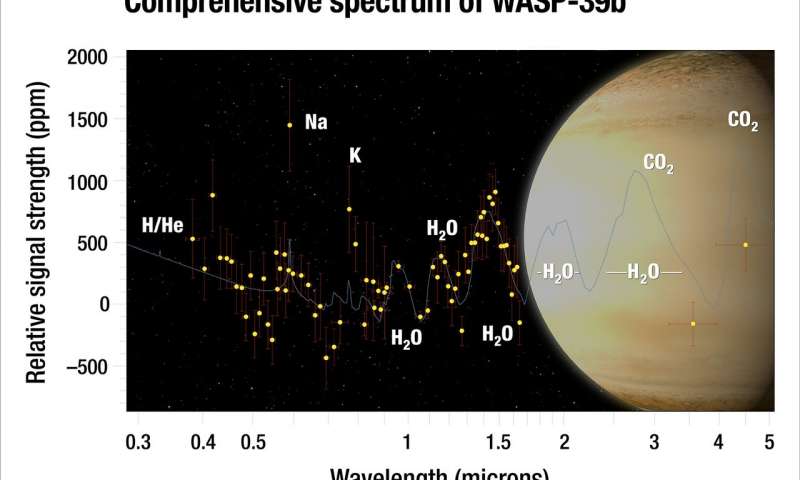
Although NASA has already confirmed thousands of exoplanets — planets outsides our solar system — what’s perhaps most staggering is their sheer diversity. Take, for instance, WASP-39b, an exoplanet located about 700 light-years away with about the mass of Saturn but which could not be any more different. By studying it in great detail, astronomers might not only learn how it formed but how planets in our own solar system’s backyard came to be as well.
A water-rich planet on fire
With the help of NASA’s Hubble and Spitzer space telescopes, astronomers were able to peer inside WASP-39b’s puffy atmosphere right to its very core. By filtering the incoming light partly absorbed by the far-away planet into individual colors, scientists could dissect the composition of its atmosphere.
“This spectrum is thus far the most beautiful example we have of what a clear exoplanet atmosphere looks like,” said lead investigator Hannah Wakeford of the Space Telescope Science Institute in Baltimore, Maryland, and the University of Exeter in Devon, United Kingdom.
This is how they learned that WASP-39b contains three times more water vapor than Saturn does. This was exciting to learn and totally atypical for a “hot Jupiter” — a class of gas giant exoplanets that are inferred to be physically similar to Jupiter but whose close proximity to the parent star results in high surface-atmosphere temperatures.
WASP-39b takes only four days to come full circle around its parent star. It’s about 20 times closer to its parent star than Earth is to the sun. It’s also tidally locked, meaning it always shows the same face to its star, like the moon.
Being this close to its star, the planet’s day-side temperature hovers at a scorching 1,430 degrees Fahrenheit (776.7 degrees Celsius). And because the exoplanet’s atmosphere is circulated by powerful winds, the night-side of the planet is also just about as hot. Unlike Saturn, WASP-39b doesn’t have any rings. What’s more, it’s atmosphere is free of high-altitude clouds, which allowed Wakeford and colleagues to easily peer down to its depths.
“WASP-39b shows exoplanets can have much different compositions than those of our solar system,” said co-author David Sing of the University of Exeter in Devon, United Kingdom, in a statement. “Hopefully this diversity we see in exoplanets will give us clues in figuring out all the different ways a planet can form and evolve.”
Due to its high water content and hot proximity to its parent star, scientists are convinced WASP-39b must have formed very differently from Saturn. Most likely, it was bombarded by many icy bodies during its early history and, quite possibly, obliterated other planetary objects in its migratory path.
WASP-39b is truly a unique world, the likes of which we’ve yet to encounter. Scientists hope to learn even more about it once the much anticipated James Webb Space Telescope launches in 2019. The powerful instruments on board the space telescope will allow astronomers to study exoplanets in much greater detail and which are much farther away than currently possible.
“By calculating the amount of carbon and oxygen in the atmosphere, we can learn even more about where and how this planet formed,” said Wakeford.






